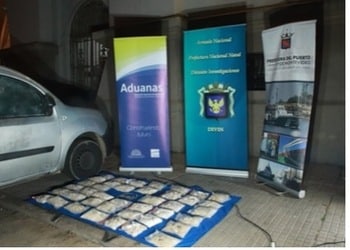What may have been the largest-ever shipment of European methamphetamine to reach Latin America has been seized in Uruguay, marking a potential turning point in the synthetic drug trade between the two continents.
Uruguayan port and naval authorities seized nearly 43 kilograms of crystal methamphetamine at the port of Montevideo on August 5, concealed within a cargo of second-hand vehicles being shipped to Paraguay from Belgium’s port of Antwerp.
The vessel had previously stopped off in Brazil and Argentina, according to Uruguayan customs, but was flagged in Paraguay, Uruguayan Navy sources told to El País.
SEE ALSO: Landlocked Paraguay Becoming Major Cocaine Link to Europe
Antwerp is a major drug link to Latin America, including as an exporter of European MDMA. In June alone, for example, Chile interdicted nearly 500,000 ecstasy pills from Antwerp and the neighboring Dutch port of Rotterdam.
However, until now methamphetamine had overwhelmingly gone the other way. InSight Crime reported in May on the growing quantities of Mexican methamphetamine arriving in and transiting through Europe, as well as on the expanding presence of Mexican drug chemists in Dutch and Belgian labs.
That assistance may well explain the Uruguayan seizure. Those Mexican cooks have not just been manufacturing methamphetamine, but also teaching local MDMA producers – those same people supplying South America’s ecstasy – how to make top-quality Mexican-style crystal.
InSight Crime Analysis
Europe’s output of methamphetamine – concentrated in Belgium and the Netherlands – is still small compared to the huge volumes being brewed in northern Sinaloa state in Mexico, one of the world’s top producers. Yet they may now be competing in the emerging South American market.
Unlike other presumed destinations for European meth, such as East Asia and Oceania, South American consumption of the drug remains extremely low, according to the United Nations’s 2022 World Drug Report. That said, reports suggest consumption may be rising in countries where synthetic drug use is already established, such as Argentina, Brazil, and Chile.
In Brazil, for instance, there have been over a dozen cases of multi-kilogram loads of methamphetamine seized in Guarulhos International Airport between 2019 and 2022, according to an InSight Crime analysis of open-source data.
Just as much product comes from Europe as from Mexico, suggesting that as usage continues to increase, Belgian-Dutch methamphetamine could be equally well-placed to meet demand.
SEE ALSO: Super Labs and Master Chefs – The Changing Face of Europe’s Drug Trade
Europe has excellent shipping links to the Southern Cone, plus growing criminal experience in the smuggling of MDMA one way and cocaine the other. Both Uruguay and Paraguay, the intercepting and recipient countries for the recent methamphetamine seizure, have also become increasingly important as drug transit hubs for Antwerp.
If the shipment had reached Paraguay, the drugs likely would have moved to neighboring countries, such as Brazil. The more interesting question, however, is how the importing criminal group paid for it.
In 2020, a kilogram of methamphetamine wholesaled in the Netherlands for around $8,000, according to the European Monitoring Centre for Drugs and Drug Addiction (EMCDDA.) Adding transport costs, that makes paying cash for European methamphetamine prohibitively expensive for South American traffickers.
That is why there is a significant chance this was a drug swap: methamphetamine for cocaine. Similar barter trades have already been detected in Brazil. An InSight Crime investigation in 2020 found that systematic MDMA-for-cocaine swaps were occurring between Europe and the state of Santa Catarina. Likewise, hashish-for-cocaine exchanges in Brazil and West Africa sparked attention in 2021.

